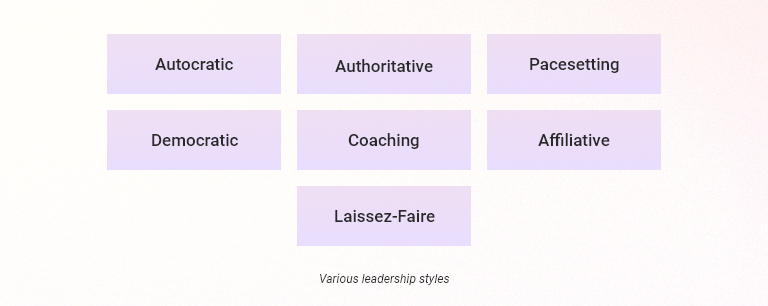December 9, 2022
OKRs and Different Styles of Leadership

“Management is doing things right; leadership is doing the right thing.” – Peter Drucker
Here, the right thing can vary in different situations with multiple routes to execute. Today’s leadership and management training and education primarily refer to a framework of 7 leadership styles. Each of these leadership styles in management has its place in a leader’s arsenal. As an effective leader, you may need to use various types of leadership styles while switching from one style to the other as circumstances demand.
In this blog, we understand each leadership style and see how an OKR framework supports different types of leadership styles.
How OKRs Differ Across Leadership Styles

Autocratic Leadership
This leadership style follows a “command-and-control” approach. The power of control here falls in a single person’s hand, i.e., the leader, and everyone else follows. Although this leadership style is seen less in today’s working environment due to its inconsiderate nature, it has its benefits too. As any other employee makes little to no input, it offers fast decision-making.
An OKR framework for this type of leadership style helps the leader focus on priorities for goal setting and better goal assignment and alignment. It promotes more accountability as the leader can delegate all the work through OKRs, while everyone knows exactly what they need to do.
Example: This leadership style stands effective if, let’s say, a building is on fire and one person must direct everyone safely out without being asked any questions.
Authoritative Leadership
Like the autocratic leadership style, the traditional approach or “visionary leadership” also runs by issuing orders. Still, leaders following this style are more considerate and believe in communicating their decisions with their employees. People can easily see where the organization is going and what must happen once they contribute to achieving its goals.
The OKR tool, like Unlock:OKR, enables employees to see their leaders and each other’s objectives and key results through complete transparency. Following an OKR framework works perfectly for this top-down goal-setting approach, where leaders share their vision with their teams, which translates organizational goals to daily work.
Example: This leadership style in management works best in uncertain and changing times.
Pacesetting Leadership
A pacesetting leadership approach is based solely on achieving goals while aiming for high performance. As a leader, you expect excellence from yourself and your teams while ensuring goals are met. The pacesetter leadership style is ideal for getting things done and driving results, but in the long run, it causes much stress to the leader and his team members. This leadership style syncs well with the OKR framework, as employees set ambitious goals for themselves and being ambitious is one of the primary features of the OKR methodology. Your employees should accomplish 75-80% of the moonshot goals. Moreover, leaders can monitor how their employees progress on their goals through OKR software, such as Unlock:OKR intuitive dashboard.
Example: This leadership is ideal when an active entrepreneur works with an energetic team developing and announcing a new product or service before the competition does that.
Democratic Leadership
The democratic leadership style is highly collaborative and encourages most participation. All suggestions from employees are welcome. Your staff may shoulder their responsibilities in a way they want to. Individuals can fully participate in the decision-making process. Though the leader makes the final decision, everyone’s input is considered for decision-making.
If you are a democratic leader, the OKR tool enables you to get inputs directly from your employees. It could be through bottom-up alignment, rolling-up OKRs, or the “conversation” feature of
Unlock:OKR tool. Besides, your teams can set their topmost priority goals and roll those up as KRs to higher-level company objectives. Employees can thus voice the company’s goals and priorities directly, helping establish team buy-in.
Example: This style of leadership is the most effective when reviewing and improving business processes and gaining “buy-in” for change.
Coaching Leadership
Are you a leader who can get the best out of his reports? If yes, the coaching style of leadership is your style. A coaching leader directs his team(s) and enables them to sharpen their skills so that they excel at what they do. You also help overcome the obstacles on their way. Coaching leaders possess excellent communication and time management skills to offer constructive feedback to individuals on their performance.
Unlock:OKR tool enables you to give personal feedback and track progress on goals, thus ensuring transparency. The weekly check-in feature of OKR software aids leaders in keeping an eye on the items or projects completed, challenges and learnings faced, items or projects in line for the next week, and upcoming obstacles.
Example: A coaching leader takes time to develop and manage talent, set clear expectations, and provide feedback for better performance.
Affiliative Leadership
Also known as collaborative leadership, the affiliate leadership style focuses on the people. It focuses on maintaining harmony amongst employees while furthering conflict resolution. As a leader, you earn your people’s support and loyalty to accomplish tasks. Not only what is done but how it is done matters in this leadership style. You recognize and reward personal behaviors and features used to implement tasks.
The OKR framework makes it easier for leaders to focus individually on their employees’ well-being. Through the weekly check-ins feature of the tool, leaders can access the progress reports of their team members and offer requisite support. Besides, they can track progress on the organization’s goals and determine if someone lags on an OKR.
Example: This leadership style works best when you lead a cross-functional project team, wherein you boost collaboration with multiple teams, departments, and vendors to achieve a shared goal.
Laissez-Faire Leadership
“Let you do” is the literal translation of Laisse-Faire from French. To understand it better, this style of leadership is the opposite of autocratic leadership. Laissez-faire leaders show trust in their people. They lead highly experienced and skilled individuals and teams, those who are motivated self-starters. Unengaged in routine work, laissez-faire leaders provide their teams will all the needed tools and resources.
An OKR software, such as Unlock:OKR, enables laissez-faire leaders to communicate their top organizational priorities better, letting teams and departments set their objectives well-aligned with the organization’s objectives. Remotely too, leaders can check the pulse of their organization through the OKR tool dashboard and step in if required.
Example: This style of leadership is the most effective when the leader confides in his team’s abilities and empowers them to shoulder their responsibilities. He also offers them timely feedback while monitoring his team’s progress on goals and accomplishments.
Are you an effective leader?
To develop as a leader, you must recognize what leadership is required, execute a strategy that may work best, and be flexible to change your leadership style as and when needed. To learn how Unlock:OKR coaches and experts help leaders become what they are, it is worth understanding how the tool works.

